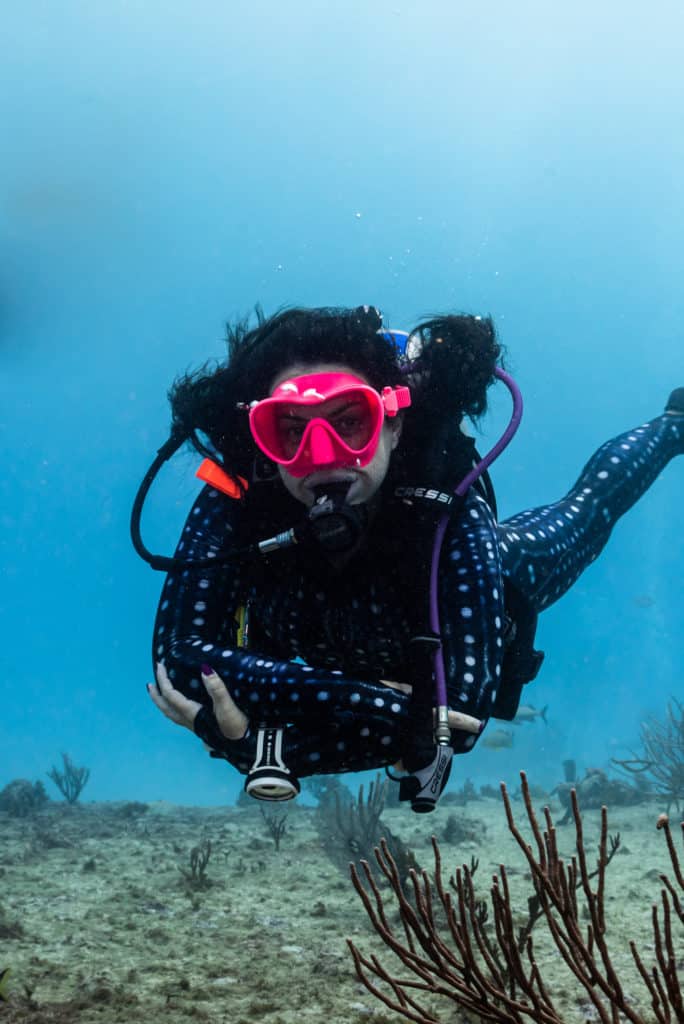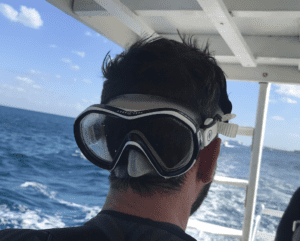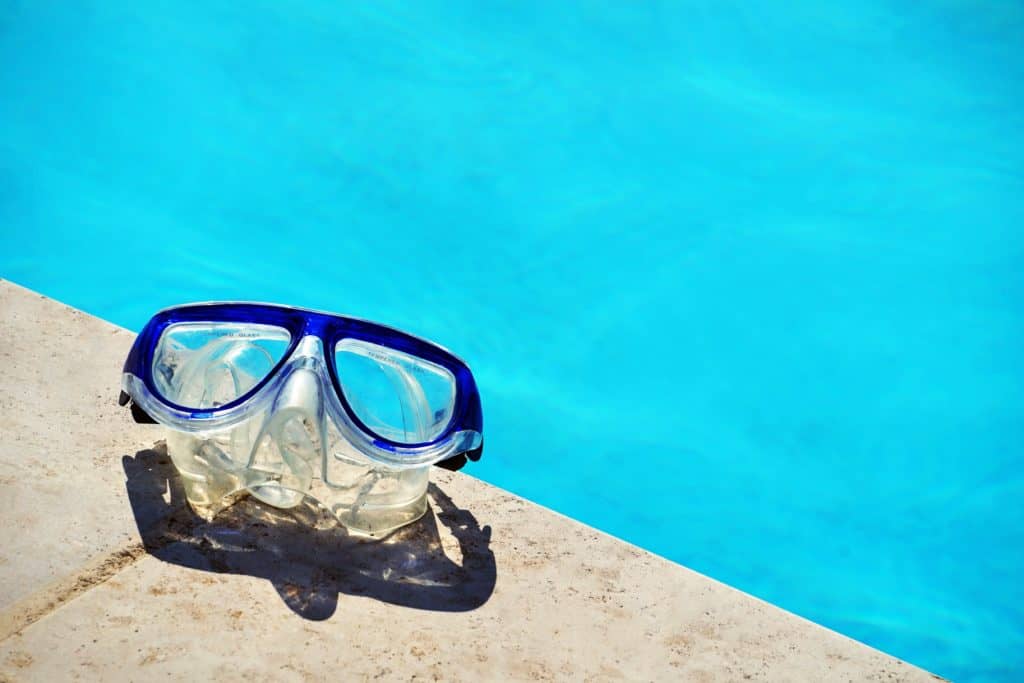A scuba mask is often the first piece of equipment that you buy as a diver. But when buying your first scuba diving mask, there are definite things to think about to make sure you are getting the one that’s right for you.
What To Look For When Choosing the Right Dive Mask
On a dive, having a mask that doesn’t fit your face or is uncomfortable can be a real annoyance.
Not only will it dig into your face in a painful manner, but a badly fitting mask will need clearing frequently underwater, and may cause a mask squeeze as a result of divers pulling the straps too tightly in an attempt to try and create a better seal.
Not all dive masks are born equal. And all divers have different shaped faces and preferences when it comes to a mask, so as well as the ultimate ‘does it fit test’, we are going to share with you some other common features to consider when buying your first dive mask
Buying Your First Scuba Mask
Try It On
One of the most important things you can ever do when purchasing a new dive mask is to try it on. It’s all well and good browsing options and colors of masks on the internet, but unless you can actually feel the materials and the fit of a mask, there’s no way of knowing if the style you prefer will actually be good for your face.
Head down to your local dive store and plan to try on everything they have! By testing all styles and shapes you can get an idea of what your own preferences are (think color/shape/volume/style) as well as getting that elusive ‘perfect fit’.
Perfect Fitting Instructions
In your local dive shop, there is a simple way to test if the mask you try fits your face well, or not.
Follow these steps for the perfect fit:
#1 – While looking up, place the mask against your face without using the strap. It should rest evenly with no obvious gaps. If it slips off, it’s too big for your face shape if it touches your cheekbones or the end of your nose, it’s probably too small for your face.
#2 – Place a regulator mouthpiece or snorkel in your mouth. When you have this in your mouth your face contracts slightly, so check that there are still no gaps.
#3 – With the mask against your face, without using the strap, gently inhale through your nose. The mask should create a seal on your face. This seal should allow you to look down at the floor and back up without the mask falling. Repeat this test with a mouthpiece in place to double-check it.
#4 – Once you’ve found a mask that seals, pull the strap over your head and wear it for a few minutes. Check it doesn’t dig in uncomfortably around the nose, or any part of your face. Check that you can easily reach the nose pocket to equalize too, as some are larger than others.
#5 – All being well, then you should have a mask that fits you perfectly. A lot of dive shops offer masks available for immediate sale and other color options available to order, so don’t let a color put you off getting the style that fits your face best.
Does the Brand of Dive Mask Matter?
Well, yes and no. There are of course price levels and brands that differ in their quality, but there’s no rule that states a more expensive mask will automatically be more comfortable and fit better. It still all depends on your face shape and preferences.
Mask Skirt Softness
The skirt is the part of the mask that creates the seal against your face. These are usually made from silicon, but not all silicons are equal. Some are thinner and create a soft second skin against your face, while others can feel hard and stiff. The only way to check this softness is to try them on, as mentioned earlier.
Avoid masks with a plastic skirt as these are not suitable for diving and will be more uncomfortable.
Mask Skirt Color
Another huge consideration for choosing a dive mask is to look at the color of the mask skirt too. It seems like dive masks come in every color of the rainbow now, especially in the more popular brands, such as Cressi F1 and the Beuchat masks.
The more common mask skirt color is black, with the darker interior blocking out reflective glare and are great for underwater photographers.
Clear skirts can allow in more light, which are better for diving in murkier waters. They can also help you feel a little less claustrophobic too. But in bright tropical conditions, they can sometimes be ‘too’ bright.

High Volume or Low Volume
The volume of your mask refers to the amount of space inside the mask. A high-volume mask fits slightly further away from your face. A high-volume mask will give you a view like looking at the underwater world as a large porthole, whereas a low-volume mask will generally give a larger field of view.
Freedivers tend to use low-volume masks as they require less effort for equalization, but they may not be as good for newer divers or those who are a little claustrophobic.
Field of View
Your field of view refers to how much you can see with your mask on. As you know, dive masks generally block out your peripheral vision, so if this is something you wish to combat, look for a wide view mask, which some manufacturers have designed for this reason.
Especially as a newer diver, you may feel more comfortable in a mask with a greater field of view as you look down to see the buckles and attachments as you adjust your BCD and clip things to your D-rings.
Lens Material
When looking at lens material for scuba diving masks, only those made with tempered, or safety glass are suitable to use at depth.
Plastic lens masks are available but are only suited for snorkeling. Under the pressure of depth, plastic lenses will not hold up well and can be dangerous. While a good scuba mask is suitable for snorkeling, the same cannot be said in reverse.
Single Lens or Multi Lens
Masks generally come as one large single lens, or with two lenses (masks with side views can have 3-4 lenses).
Depending on your preference, a single lens mask will generally be a higher volume and sit further from your face, while a multi-lens mask can mold close around your face.
Try them on to see which you prefer. Single-lens masks tend to be lighter too.
Reflective Lenses
Some masks offer reflective lenses. These can look cool and help to limit glare in extremely sunny environments. However, as a new diver these types of masks are probably not the best idea.
A lot of the time your buddy can see signs of stress or anxiety through the eyes and without being able to speak underwater, communication through the eyes is vital.
Prescription Lenses
If you wear eyeglasses above land, you may want to have a prescription underwater too, especially when looking for your buddy, to enjoy the macro life, or even to read your gauge and computer.
Check in your local dive shop which masks are compatible for prescription lenses. Those with multiple lenses allow for a more precise prescription as these allow for each eye to have a different prescription level.
Mask Strap
Finally, once you are satisfied with the fit of the skirt, the field of view, and the color, adjust the strap so it fits to your head.
Most modern masks have a similar adjustment method for making them fit you well. One mistake most new divers make is pulling their mask way too tight to make it ‘fit better’. This is a myth and a mask with a perfect fit doesn’t need to be uncomfortably tight. This will only put pressure on your face and sinuses and leave you with that tell-tale mask circle for the hours following your dive.
Another recommended accessory, especially for divers with longer hair is a neoprene mask strap. These slide over the rubber mask strap and prevent them from ripping hairs from your head as you pull them on and off.

Clean Your New Mask To Prevent Fogging
When you do buy your first mask, it’s important to clean it carefully before you use it in the ocean on a dive, otherwise, it will be incredibly foggy and you won’t be able to see through it!
Follow our tips in this guide for ‘How to clean a new scuba mask‘
Make a Personalized Choice when Buying your First Scuba Diving Mask
To round up, a scuba mask is a super personal piece of equipment. While BCDs and fins can be borrowed and exchanged without much of a noticeable difference, a scuba mask is your key item than can truly make or break a dive.
So how do you get the right one, try them on in person. It’s a bit of a Cinderella exercise, to find the perfect fit, but you’ll know when you find the right one for you.


